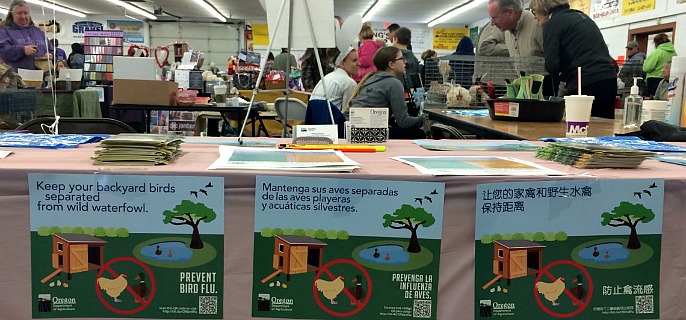
PHOTO COURTESY OF ODA
After surviving last fall and winter without a case of highly pathogenic bird flu virus, Oregon and other states inside the Pacific Flyway are once again bracing for the possibility of migratory waterfowl introducing the disease to backyard birds and other domestic poultry.
Outreach and education efforts are ramping up in hopes that bird owners get the message that biosecurity is critical to reducing the risk of highly pathogenic avian influenza (HPAI) from showing up in the months to come.
Avian influenza naturally resides in wild birds and it is fairly common for waterfowl to carry various strains of the virus.
“I would say that the current threat level is certainly elevated,” says State Veterinarian Dr. Brad LeaMaster with the Oregon Department of Agriculture. “We don’t have the resources to conduct large scale surveillance studies in the wild waterfowl population, but the detection of HPAI in Alaska late August told us that the virus is there, and has maintained itself in its natural host. It is highly likely that the fall migration will bring the virus down the Pacific Flyway and back to Oregon.”
Cool, wet weather provides optimal conditions for influenza viruses, including HPAI. That increases the chance of transmission from a wild waterfowl host to domestic poultry.
Oregon may have dodged a bullet last year after two cases of HPAI reported in backyard birds the previous winter. But 2015 delivered a devastating blow to commercial poultry in the Midwest as HPAI was responsible for the deaths of more than 50 million birds. Oregon’s commercial poultry industry has not been affected by HPAI and has employed its own set of strong biosecurity measures.
Outreach and education efforts this year, once again, are focused on backyard bird owners, some of whom may have been lulled into a false sense of security after a quiet 2015 in Oregon.
“People are people and, for better or worse, one of our attributes is that we tend to forget historical events quickly– especially if we are not directly connected with the event,” says LeaMaster. “I doubt that very many citizens are even aware of the 2014-2015 outbreak. That is why we are gearing up our efforts so we can raise the awareness of the subject, especially to those with backyard poultry.”
ODA, working with other partners such as the US Department of Agriculture’s Animal Plant Health Inspection Service (APHIS) and the Oregon Department of Fish and Wildlife (ODFW), has made outreach and education a high priority ever since HPAI showed up in the Pacific Northwest in 2014. The messages haven’t changed too much but the number of poultry owners hearing the messages has reached into the tens of thousands.
In addition to practicing good biosecurity, backyard bird owners should monitor their flock closely and report sick or dead birds to ODA at 1-800-347-7028. That same phone number should be used anytime backyard poultry enthusiasts, commercial producers, or the general public have questions about avian influenza.
With more good luck and strong biosecurity measures, Oregon can have another quiet HPAI season.








